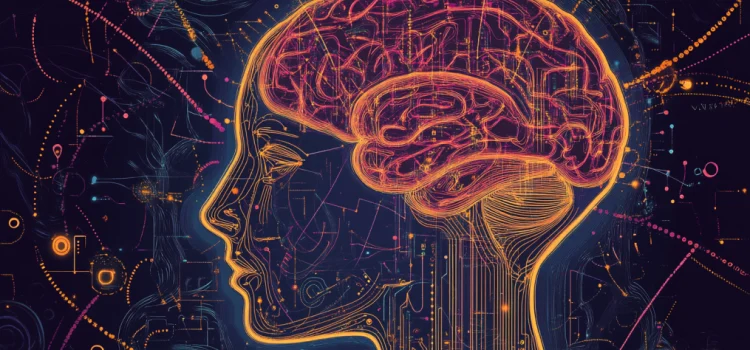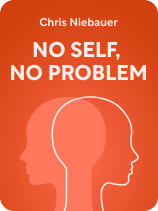

This article is an excerpt from the Shortform book guide to "No Self, No Problem" by Chris Niebauer. Shortform has the world's best summaries and analyses of books you should be reading.
Like this article? Sign up for a free trial here.
What does the left brain do? How does it shape our perception of reality and ourselves?
In No Self, No Problem, Chris Niebauer explores the fascinating role of the left brain in creating our sense of self. He delves into how this hemisphere constructs narratives from our experiences, using language and pattern recognition to make sense of the world around us.
Continue reading to discover what the left brain does and how it influences your daily life.
The Left Brain Creates the Self by Building Stories From Our Experiences
What does the left brain do? The left brain works to make sense of the world. Niebauer explains that it creates a continuous story to explain what we experience, how we behave, and who we are. This story creates our sense of self. Telling a story involves building sequences and categories of events and information. So the left brain is often thinking about what happened in the past and what might occur in the future, rather than living in the present.
(Shortform note: Philosopher Daniel Dennett agrees with Niebauer that we create our sense of self by telling stories. To explain, he uses the metaphor of an object’s center of gravity: the imaginary point where all of the weight of the object is concentrated. The center of gravity is useful for calculations, like if you want to figure out how easy an object would be to knock over or how it might fall if you dropped it. But the center of gravity isn’t a real, concrete location that you’d be able to identify in a real object like a book or an umbrella or a sock. Dennett says in the same way, we use the self as a “center of narrative gravity” to make everything we know about our experiences, plans, and preferences cohere around a point. But that point itself isn’t real.)
Niebauer explains that, to fit everything we know about ourselves and our lives into a comprehensive narrative, the left brain constantly works to explain what’s going on, what we’re doing, and what we’re thinking. The left brain comes up with a story to explain what it observes, even when it has absolutely no idea why things are the way they are. Niebauer explains that it’s also completely convinced the explanations it comes up with are correct, even when they aren’t based on reality and in fact often do a bad job of explaining what we observe.
(Shortform note: While Niebauer contends the left brain takes the lead in helping us make sense of the world, psychiatrist Iain McGilchrist argues in The Master and His Emissary that the right brain is crucial in helping us understand our experiences. McGilchrist notes that the losses to a person’s ability to understand the world are much more profound after a stroke to the right hemisphere than to the left. He explains that because the left brain sees the world as individual events and objects, and the right brain sees things in their context, the right brain is better equipped to understand the meaning of what we experience. He contends the left brain doesn’t know much of anything—but it’s very confident that it knows everything, as Niebauer notes.)
According to Niebauer, the left brain has the odd tendency to fluently explain our actions even when it has no idea why we’re behaving as we are. To demonstrate how this works, he cites the example of people called “split-brain patients,” who have had their corpus callosum severed to treat severe epilepsy and reduce the intensity of the debilitating seizures it causes. When the right brain of a split-brain patient follows instructions the left brain can’t access, the left brain doesn’t admit it doesn’t know why the person is completing an action. Instead, it invents (and believes) a story to explain the behavior.
For example, imagine you show a split-brain patient two different words: You show the word “cat” to his right visual field (the area to the right of his nose) and the word “dog” to his left visual field. The brain is cross-wired, so the right side of the brain controls and receives information from the left side of the body, and vice versa. That means you’ve shown “cat” to the patient’s left brain and “dog” to his right brain. So if you ask him to use his left hand—which is controlled by his right brain—to draw the word he just saw, he’d draw a dog, because that’s what his right brain saw. His left brain wouldn’t know why, since it saw the word “cat.” The patient might explain by saying dogs and cats are both common pets, and a dog is easier to draw. In other words, his left brain makes up an explanation to make sense of what it doesn’t understand.
(Shortform note: Very few patients have ever undergone the surgical procedure to sever the corpus callosum, and only 10 of them have undergone extensive tests to see how the two sides of the brain behave when they can’t communicate directly. However, patients who have had the surgery say their sense of consciousness doesn’t feel split. In fact, they say they don’t feel any different after the procedure than they did before. Michael S. Gazzaniga—one scientist whose work with split-brain patients Niebauer cites in the book—explains this is because the left brain doesn’t miss its access to the right brain. It just carries on generating explanations for actions initiated by the right brain—even if those explanations seem a little bizarre.)
Niebauer explains that the left brain uses two tools to create the narratives and sense of self that shape how we perceive our world: language and pattern recognition. We’ll look at the details of each of these next.
Language
The left brain is the dominant side of the brain for the use of language. It produces the internal monologue many people hear in their heads. Through this monologue—which sounds like “you” talking to yourself within your mind—your left brain gives a voice to your observations, thoughts, and judgments. These are all, by nature, subjective, and often wrong. But because the left brain puts them into language, they feel real.
(Shortform note: Not everyone has an internal monologue to shape their sense of self or reality. Psychologist Russell Hurlburt estimates that between 30% and 50% of people frequently have an inner monologue. In this monologue they hear themselves thinking in their mind, often talking themselves through a task or figuring out how to solve a problem. Hurlburt says most people who experience an inner monologue don’t hear it all the time and go through much of their day without hearing it at all. People who don’t hear an inner monologue think in different ways: For example, scientist Temple Grandin explains in Visual Thinking that people with autism may think by visualizing images, seeing patterns, or putting things into words—or in a mix of these.)
Because language makes them feel real, you usually don’t question the left brain’s explanations, whether in your inner monologue or in your thoughts and judgments. Niebauer argues this leads to negative experiences, like when your left brain convinces you your best friend is upset at you or talks you into believing you failed an exam, even though it doesn’t have compelling evidence for either story.
(Shortform note: Your left brain’s storytelling ability is great when the story your brain tells you corresponds with reality—but things can go wrong when the narrative diverges from the truth. This happens in obsessive-compulsive disorder (OCD)—a person’s brain invents a story that convinces them something terrible will happen if they don’t do a very specific thing to prevent it. Or, in schizophrenia, people often hear hallucinated voices that originate in the left brain and its mechanisms for internal monologue. These seemingly external voices speak to them and often tell them what to do. The Collected Schizophrenias author Esmé Weijun Wang explains these hallucinations “kidnap the senses,” telling a convincing and often harmful story that isn’t true.)
Another way the left brain’s facility with language leads us astray is by convincing us the categories and labels it comes up with are real. Niebauer explains the left brain is so invested in the reality of the language it uses to describe the world that it sometimes thinks the abstractions and arbitrary categories it dreams up are real or definitive—but they aren’t. For instance, your brain might label the people in your life as “good” or “bad” and assume they’ll always act accordingly. But in reality, everyone’s behavior and moral character is nuanced—and most people believe that doing one good or bad thing doesn’t make someone a good or bad person.
(Shortform note: As Niebauer notes, language makes things feel real, and it shapes perception in surprising ways. For example, the human eye can see millions of different colors, and we use language to put them in categories, like “red,” “orange,” or “yellow.” If you know names for more shades of a color—red ochre, quinacridone red, vermillion, or madder—you can distinguish shades others might not. Knowledge of this effect seems to have led to a strange myth that the ancient Greeks couldn’t see the color blue because they didn’t have a word for “blue.” So when Homer describes the “wine-dark sea,” some readers assume the blue of the ocean didn’t register to the ancient Greek eye—overestimating language’s role in influencing how we see color.)
Pattern Recognition
Intrinsic to the left brain’s ability to produce language and construct categories is another key function of this half of the brain: its tendency to search for patterns. Niebauer notes that we see patterns everywhere, even where none actually exist. That’s what causes the left brain to separate things into categories, make judgments, and apply labels, often erroneously.
(Shortform note: Scientists call the tendency to see patterns in random events apophenia. Apophenia may arise from an overactive right brain, and it makes unrelated things seem connected. It helps us see images in Rorschach blots and create insightful metaphors—or makes us see ghosts and fall for conspiracy theories. Vladimir Nabokov explores apophenia in “Symbols and Signs.” The story follows the elderly parents of a man who’s institutionalized for seeing messages in everything, a real symptom of psychosis. Much of what happens in the story goes unexplained, which sends the reader scrambling to connect the dots—an unsettling experience that leaves some readers engaging their own apophenia to try to make sense of it.)
Niebauer says the tendency to search for patterns—and to find them, whether they’re real or not—contributes to our belief in the self. When the left brain looks at our thoughts, memories, and preferences, it looks for connections in these enormous sets of information. The pattern that emerges is the self. The self is wildly convincing to the left brain, but that doesn’t mean it’s real.
(Shortform note: Some experts say your brain uses patterns not only in the information it’s gathered about your thoughts—as Niebauer explains—but also patterns in its information about the outside world to construct your sense of self. In The Self Illusion, psychologist Bruce Hood says your sense of self is a little like the kind of optical illusion called an “illusory contour”—like the Kanizsa triangle. In this illusion, you see a bright white triangle even though there aren’t any lines outlining one because your brain “hallucinates” the triangle from the surrounding lines and shapes. Hood contends that similarly, your brain spins your sense of self out of negative space in the information about what you perceive to create a self-portrait of the perceiver: you.)

———End of Preview———
Like what you just read? Read the rest of the world's best book summary and analysis of Chris Niebauer's "No Self, No Problem" at Shortform.
Here's what you'll find in our full No Self, No Problem summary:
- Why everything you know about yourself is wrong
- How science is catching on to what Eastern religions have been teaching for millenia
- How to loosen your grip on the thoughts and judgments that make you dissatisfied with your reality






